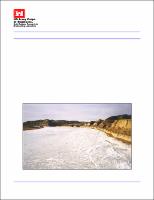Please use this identifier to cite or link to this item:
https://hdl.handle.net/11681/2596| Title: | Ice engineering : ice cover effects on scour in narrow rivers |
| Authors: | Zabilansky, Leonard J. White, Kathleen D. |
| Keywords: | Ice Ice sheets Rivers Geomorphology Sediment transport Scour and fill |
| Publisher: | Cold Regions Research Engineering Laboratory (U.S.) Engineer Research and Development Center (U.S.) |
| Series/Report no.: | ERDC/CRREL ; TN-05-3 |
| Abstract: | The influence of an ice cover on a channel involves complex interactions among the ice cover, ice roughness, fluid flow, sediment, bed geometry, water depth, and channel geometry. This complex interaction can have a dramatic effect on sediment transport process (Fig. 1) and channel development, especially in narrow rivers. A river is considered narrow if the ice in the center of the channel is constrained from responding to changes in water level. In these situations, any increase in the discharge above the level at freezeup will necessarily be accompanied by an increase in the velocity under the ice cover. Recent laboratory investigations of scour around bridge piers explored three surface conditions: open water, a floating ice cover, and a restrained ice cover with hydrostatic head conditions simulating discharge increased above freezeup level. The study concluded that increases in hydrostatic head caused an increase in the maximum velocity beneath the ice cover for the restrained case and also found that the velocity profile is shifted towards the smoother boundary. This technical note summarizes the more detailed descriptions of the experiments contained in Hains (2004), Hains and Zabilansky (2004), and Hains et al. (2004). |
| Description: | Technical Note |
| Gov't Doc #: | ERDC/CRREL TN-05-3 |
| Rights: | Approved for Public Release; Distribution is Unlimited. |
| URI: | http://hdl.handle.net/11681/2596 |
| Appears in Collections: | Technical Note |
Files in This Item:
| File | Description | Size | Format | |
|---|---|---|---|---|
| CRREL-TN-05-3.pdf | 303 kB | Adobe PDF |  View/Open |